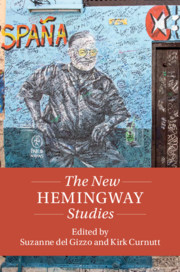Book contents
- The New Hemingway Studies
- Twenty-First-Century Critical Revisions
- The New Hemingway Studies
- Copyright page
- Contents
- Contributors
- Introduction Hemingway in the New Millennium
- Part I The Textual Hemingway
- Chapter 1 Shaping the Life
- Chapter 2 Hemingway and Textual Studies
- Chapter 3 Correspondence and the Everyday Hemingway
- Chapter 4 Object Studies and Keepsakes, Artifacts, and Ephemera
- Chapter 5 Digital Hemingway
- Part II Identities
- Part III Global Engagements
- Works Cited
- Index
Chapter 5 - Digital Hemingway
from Part I - The Textual Hemingway
Published online by Cambridge University Press: 30 August 2020
- The New Hemingway Studies
- Twenty-First-Century Critical Revisions
- The New Hemingway Studies
- Copyright page
- Contents
- Contributors
- Introduction Hemingway in the New Millennium
- Part I The Textual Hemingway
- Chapter 1 Shaping the Life
- Chapter 2 Hemingway and Textual Studies
- Chapter 3 Correspondence and the Everyday Hemingway
- Chapter 4 Object Studies and Keepsakes, Artifacts, and Ephemera
- Chapter 5 Digital Hemingway
- Part II Identities
- Part III Global Engagements
- Works Cited
- Index
Summary
In “Digital Hemingway,” Laura Godfrey offers an in-depth overview of Hemingway’s growing presence on the Internet since 2000. At the start of the new millenium, website technology and in particular interactive maps were relatively primitive. Hemingway fans/followers such as Michael Palin – the former Monty Python comedian whose late-1990s BBC series Hemingway Adventure popularized Hemingway tourism – employed only basic interactive technologies, relying on more analog experiences. Soon, however, advances in programming allowed for modes of mapping and spatial assessment that broadened the way readers could visualize place in Hemingway. With the introduction of e-books c. 2004, the experience of the Hemingway “book” also transformed – so too with access to images of Hemingway online and of clips on YouTube, in particular his playfully weird acceptance of the Nobel Prize in 1954. Godfrey also examines Hemingway’s place among the ever-proliferating memes that online users create and circulate. She also discusses the roles he plays in various forms of online gaming. All of these technologies have transformed the relationship between the reader and Hemingway’s writing.
- Type
- Chapter
- Information
- The New Hemingway Studies , pp. 80 - 96Publisher: Cambridge University PressPrint publication year: 2020

